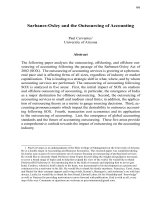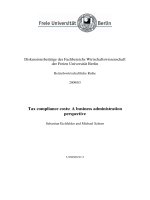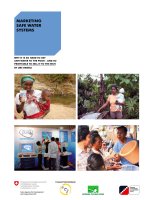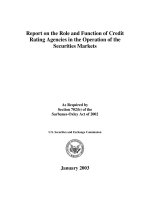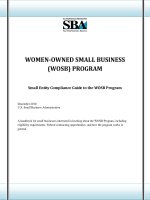Profitable sarbanes oxley compliance
Bạn đang xem bản rút gọn của tài liệu. Xem và tải ngay bản đầy đủ của tài liệu tại đây (1.24 MB, 289 trang )
Profitable
Sarbanes-Oxley
Compliance
Attain Improved Shareholder Value
and Bottom-Line Results
BY
C. Lynn Northrup CPA, CPIM
J. Ross Publishing; All Rights Reserved
Copyright ©2006 by J. Ross Publishing, Inc.
ISBN 1-932159-35-5
Printed and bound in the U.S.A. Printed on acid-free paper
10 9 8 7 6 5 4 3 2 1
Library of Congress Cataloging-in-Publication Data
Northrup, C. Lynn, 1939Profitable Sarbanes-Oxley compliance : attain improved shareholder value
and bottom-line results / by C. Lynn Northrup.
p. cm.
Includes index.
ISBN 1-932159-35-5 (hardback : alk. paper)
1. Disclosure in accounting—United States. 2. Corporate
governance—United States. 3. Auditing, Internal—United States. 4.
Managerial accounting—United States. 5. Financial statements—United
States. 6. United States. Sarbanes-Oxley Act of 2002. I. Title.
HF5658.N67 2005
657′.3—dc22
2005022253
This publication contains information obtained from authentic and highly regarded sources.
Reprinted material is used with permission, and sources are indicated. Reasonable effort has
been made to publish reliable data and information, but the author and the publisher cannot
assume responsibility for the validity of all materials or for the consequences of their use.
All rights reserved. Neither this publication nor any part thereof may be reproduced,
stored in a retrieval system or transmitted in any form or by any means, electronic, mechanical, photocopying, recording or otherwise, without the prior written permission of the
publisher.
The copyright owner’s consent does not extend to copying for general distribution for
promotion, for creating new works, or for resale. Specific permission must be obtained from
J. Ross Publishing for such purposes.
Direct all inquiries to J. Ross Publishing, Inc., 5765 N. Andrews Way, Fort Lauderdale,
Florida 33309.
Phone: (954) 727-9333
Fax: (561) 892-0700
Web: www.jrosspub.com
J. Ross Publishing; All Rights Reserved
DEDICATION
This book is dedicated to my wife, Jessica, who tirelessly edited, provided
suggestions, made improvements, and enhanced the diagrams. Thank you for
all your help, support, and guidance.
J. Ross Publishing; All Rights Reserved
J. Ross Publishing; All Rights Reserved
TABLE OF CONTENTS
The Author ...................................................................................................... xi
Web Added Value™ .................................................................................... xiii
Chapter 1. A Call for Governance ............................................................. 1
Greed, Not Governance ................................................................................... 2
Ethics without Honor ....................................................................................... 2
Management without Responsibility ............................................................... 3
Enron’s House of Cards .................................................................................. 5
Arthur Andersen’s Implosion .......................................................................... 6
Asleep at the Wheel ........................................................................................ 7
Business Process Management ........................................................................ 9
Challenges of Corporate Performance Management .................................... 10
Tone at the Top ............................................................................................. 11
Chapter 2. Sarbanes-Oxley Response .......................................................
Legislative Response .....................................................................................
Cost of Ethics ................................................................................................
Oversight Board .............................................................................................
Officer Certification .......................................................................................
Financial Reporting Disclosures ...................................................................
Management’s Assessment of Internal Controls ..........................................
Code of Ethics ...............................................................................................
New Rules of the Road .................................................................................
The Audit Committee Watchdog ..................................................................
The New Executive Look .............................................................................
J. Ross Publishing; All Rights Reserved
15
16
17
18
19
20
22
24
25
27
27
v
vi
Profitable Sarbanes-Oxley Compliance
Chapter 3. Setting the Tone .......................................................................
The New Reality ............................................................................................
Responsibilities of Leadership ......................................................................
Principles-Based Accounting Standards .......................................................
Relevant Measurement ...................................................................................
Self-Assessment .............................................................................................
Audit Challenges ............................................................................................
Boards Can Make a Difference ....................................................................
29
29
31
33
35
37
39
40
Chapter 4. Relevance of Risk ....................................................................
Reliable Risk ..................................................................................................
COSO Framework .........................................................................................
ERM Framework ...........................................................................................
Strategic and Other Objectives .....................................................................
Control Environment and Activities .............................................................
Identifying Events ..........................................................................................
Assessing Risk ...............................................................................................
Responding to Risk .......................................................................................
Effective Business Processes .........................................................................
Integrating Risk Governance .........................................................................
43
44
45
47
50
52
56
59
61
62
63
Chapter 5. A Dynamic Process ..................................................................
Internal Control Defined ...............................................................................
Process Based .................................................................................................
People Driven .................................................................................................
Concept of Reasonable Assurance ................................................................
Framework Composition ...............................................................................
Oversight Model for Compliance .................................................................
Framework Limitations ..................................................................................
External Financial Reporting .........................................................................
65
65
66
68
70
71
73
74
75
Chapter 6. Design Effectiveness ................................................................
Document Controls ........................................................................................
Evaluate Design .............................................................................................
Operating Effectiveness .................................................................................
COSO Evaluation Criteria .............................................................................
Strategic Design .............................................................................................
Organizational Design ...................................................................................
Supply Chain Implications ............................................................................
ERP Advantage ..............................................................................................
77
77
80
83
85
87
88
90
91
J. Ross Publishing; All Rights Reserved
vii
Table of Contents
CRM to Sales Force Automation .................................................................
Data Warehousing ..........................................................................................
Business Intelligence .....................................................................................
Business Process Management ......................................................................
92
93
94
95
Chapter 7. Control Environment Responsibilities .................................. 97
Management Responsibility ........................................................................... 97
Organizational Tone ....................................................................................... 99
Blueprint for Action .................................................................................... 100
Organizational Integrity ............................................................................... 102
Knowledge Effectiveness ............................................................................. 103
Management Philosophy .............................................................................. 104
Continuous Compliance and Improvement ................................................ 105
Cornerstone of Competitive Advantage: Knowledge Management .......... 106
Chapter 8. Information Technology Issues and Concerns ..................
Information Technology and Internal Control ...........................................
Enterprise Management and Business Processes .......................................
The COBiT Framework ...............................................................................
Sarbanes-Oxley Compliance Tools .............................................................
The Governance Challenge .........................................................................
Assessing IT Readiness ...............................................................................
IT Control Objectives ..................................................................................
Control Reliability .......................................................................................
109
110
113
115
117
120
121
124
127
Chapter 9. Information Security: A Corporate Governance
Challenge .....................................................................................................
Information Security Governance ...............................................................
Accountability and Awareness ....................................................................
Structure and Integration .............................................................................
Challenge of E-Business .............................................................................
Assessing and Managing Risk ....................................................................
Security Access: How Secure Is Secure? ..................................................
The Internet Revolution ...............................................................................
Information Warfare ....................................................................................
Information Security Tools .........................................................................
131
132
133
135
138
140
141
143
144
145
Chapter 10. Real-Time Governance ........................................................ 147
Ongoing Monitoring .................................................................................... 148
Separate Evaluations .................................................................................... 150
J. Ross Publishing; All Rights Reserved
viii
Profitable Sarbanes-Oxley Compliance
Deficiency Identification .............................................................................
Reasonable Assurance .................................................................................
Control Gaps ................................................................................................
Defining Compliance Risk ..........................................................................
Benchmarking Compliance ..........................................................................
Culture and Change .....................................................................................
Linking Performance and Value .................................................................
Real-Time Governance ................................................................................
151
152
154
157
158
160
160
161
Chapter 11. Self-Assessment ....................................................................
Management Assessment of Internal Control ............................................
Auditor Attestation of Management’s Assessment ....................................
Legislative Intent .........................................................................................
The Self-Assessment Process ......................................................................
Assessment Planning ...................................................................................
The Assessment Team .................................................................................
Assessment Tool Kit ...................................................................................
Going Beyond Compliance .........................................................................
163
164
166
168
169
172
174
177
179
Chapter 12. New Meaning of Independence .........................................
New Rules of the Road ...............................................................................
Management’s New Role and Rules ..........................................................
The New Audit Committee .........................................................................
Financial Experts Required .........................................................................
Audit Impact and Meaning .........................................................................
The Future Is Now ......................................................................................
Boards Go to School ...................................................................................
Strategic Execution ......................................................................................
Retooling and Retraining .............................................................................
181
181
183
184
185
186
188
189
190
191
Chapter 13. The Cascade Effect .............................................................
Just Good Business ......................................................................................
Exit Strategy .................................................................................................
The Fraud Triangle ......................................................................................
The New Benchmark ...................................................................................
Third-Party Issues ........................................................................................
Copycat Legislation .....................................................................................
Internal Audit Challenges ............................................................................
Looking Ahead .............................................................................................
193
193
194
195
197
198
200
201
202
J. Ross Publishing; All Rights Reserved
Table of Contents
ix
Chapter 14. New World of Auditing .....................................................
Independent Oversight .................................................................................
Two Sets of Audit Standards ......................................................................
AICPA: Regaining Lost Relevance ............................................................
FASB and GAAP ........................................................................................
Principles-Based Accounting .......................................................................
Audit Standards for the Nonauditor ...........................................................
Control Deficiencies ....................................................................................
New World of Governance .........................................................................
Big GAAP and Little GAAP ......................................................................
Future Accounting and Auditing Now .......................................................
205
205
207
208
209
211
213
217
219
220
222
Chapter 15. Strategy and Communication ............................................
Communication of Strategy .........................................................................
Linkage Strategic and Operational Effectiveness ......................................
Getting Information to Flow .......................................................................
Right Measurement at the Right Time .......................................................
Business Intelligence ...................................................................................
Methodologies for Real-Time Measurement ..............................................
Effective Information for Reliable Processes .............................................
225
226
228
230
232
234
236
238
Chapter 16. Beyond Compliance .............................................................
Building a Trustworthy Foundation ............................................................
Accelerated Flow .........................................................................................
Creating Speed and Reliability ...................................................................
Business Performance Management ...........................................................
Business Process Management and Measurement .....................................
From Compliance to Competitive Advantage ............................................
Continuous Compliance and Management .................................................
241
242
243
244
246
249
252
253
References ................................................................................................... 255
Index ............................................................................................................ 263
J. Ross Publishing; All Rights Reserved
J. Ross Publishing; All Rights Reserved
THE AUTHOR
C. Lynn Northrup is the principal of C.
Lynn Northrup, CPA, based in Wilmington,
North Carolina. In addition to his CPA and
consulting practice, he develops and teaches
continuing professional education programs
and is the author of Dynamics of ProfitFocused Accounting, published by J. Ross
Publishing in 2004. Lynn was previously
with McGladrey & Pullen’s national manufacturing consulting practice, where his specialty was conducting operational and
workflow assessments focused on business
process improvement and performance measurement. He also worked on the application of strategic cost management and
analysis concepts.
After starting his career in public accounting with Arthur Young and
PriceWaterhouseCoopers, he was the controller at Schlegel Corporation in Rochester, New York. Schlegel, a complex multinational manufacturing company,
grew rapidly from $10 million in sales to $300 million from 1965 to 1984. Lynn
developed and implemented the cost accounting, financial, and budget forecasting systems for this company on a worldwide basis, which included over 35
profit centers located in 17 different countries.
In addition to creating his own CPA and advisory practice, Lynn has held
various management and executive positions in industry, including controller
and vice president of finance. His experience includes working with a wide
variety of manufacturing companies in diverse industries, construction, and
J. Ross Publishing; All Rights Reserved
xi
xii
Profitable Sarbanes-Oxley Compliance
service industries, including CPA firms, mail order, hospitality, real estate, and
nonprofit organizations.
Lynn received a B.B.A. from Clarkson University in 1960 and was certified
in production and inventory management (CPIM) with APICS in 1999. He is
licensed as a Certified Public Accountant in New York, North Carolina, and
Oregon and is member of the American Institute of Certified Public Accountants and the North Carolina Association of CPAs. He is also an active member
of APICS. Lynn can be reached at
J. Ross Publishing; All Rights Reserved
Free value-added materials available from
the Download Resource Center at www.jrosspub.com
At J. Ross Publishing we are committed to providing today’s professional with
practical, hands-on tools that enhance the learning experience and give readers
an opportunity to apply what they have learned. That is why we offer free
ancillary materials available for download on this book and all participating
Web Added Value™ publications. These online resources may include interactive versions of material that appears in the book or supplemental templates,
worksheets, models, plans, case studies, proposals, spreadsheets and assessment
tools, among other things. Whenever you see the WAV™ symbol in any of our
publications, it means bonus materials accompany the book and are available
from the Web Added Value Download Resource Center at www.jrosspub.com.
Downloads available for Profitable Sarbanes-Oxley Compliance: Attain
Improved Shareholder Value and Bottom-Line Results consist of the following:
The performance measurement scorecard is a baseline assessment scorecard for
conducting self-assessments that contain both financial and nonfinancial metrics.
It is in Excel template format. The self-assessment checklist and scoring template is a guide and checklist to assist internal auditors and management when
performing a self-assessment of the control environment. It provides a weighted
scoring of answers and is in Excel template format. The Sarbanes-Oxley compliance management checklist provides key questions for management relative
to Sarbanes-Oxley compliance in checklist format. The business process management checklist provides critical questions for management relative to the
effectiveness of business processes in checklist format. The compliance and
internal control resources and tools provide key resources to compliance questions, together with hyperlinks that will assist in accessing critical information
and data, including authoritative information as well as useful web sites that
reference software and other tools.
J. Ross Publishing; All Rights Reserved
xiii
J. Ross Publishing; All Rights Reserved
1
A CALL FOR
GOVERNANCE
The world changed in 2001. Terrorists attacked the U.S. homeland, the economy
plunged into recession, and corporate fraud destroyed the pensions and retirement plans of millions of people. The competitive landscape in the 21st century
has become brutal with global outsourcing of jobs. The speed of innovation
accelerated, with the customer becoming the focus of attention. Corporations
are learning that knowledge management and intellectual capital have become
a strategic and competitive necessity. These issues have challenged corporate
leadership and created pressure that produced fraudulent and illegal activities
at the highest corporate levels, which continue to capture newspaper and television headlines. CEOs and CFOs were being judged by how effectively they
managed their quarterly earnings and not on the value created by the corporation. Likewise, audit firms became focused on cross-selling nonaudit services,
not on the quality of audits being conducted. These corporate scandals involving
fraudulent accounting not only rocked investor confidence, but also exposed the
weaknesses in business processes and internal controls that have eroded corporate competitiveness.
It has become the trend to mix black and white with varying shades of grey.
Financial statements within the guidelines of generally accepted accounting
principles (GAAP) have become the tools to drive stock prices and increase
executive compensation by making one plus one equal three. The average
CEO’s paycheck was more than 500 times that of the average production worker’s
by the year 2000. Stock options or other performance-based pay have become
almost 80% of CEO compensation. It is little wonder that top corporate management bent the rules in favor of its own interests. In essence, greed overcame
ethics and corporate governance.
J. Ross Publishing; All Rights Reserved
1
2
Profitable Sarbanes-Oxley Compliance
GREED, NOT GOVERNANCE
Governance relies on individuals to make ethical decisions based on determining what is morally right within the context of corporate culture and policies.
The impact of the dot.com bust and the soft economy left managers and executives in uncharted waters. The lack of a compass and a map combined with
greed and the feeling that they could get away with cooking the books without
repercussion was a sure-fire recipe for fraud and deceit. Acts of misconduct
by employees, according to the 2003 National Business Ethics Survey, included abusive behavior, misreporting of data, lying, and withholding of needed
information.
Clearly, the continuing stream of misrepresented financial results and corporate fraud stems from a lack of governance at the top that permeates all levels
of the organization. The 2003 survey indicated a tendency for younger employees with low tenure to avoid reporting misconduct. We have seen younger
managers caught in the cross-fire of fraud because they were ambitious to a fault
and did not have effective guidelines. There was a failure of organizations to
provide ethics programs and education and training that would help managers
through the defining moments of choosing right from wrong. These failures
combined with a lack of accountability for improper actions have led far too
many executives in trusted positions to take the wrong turn when facing a fork
in the road.
A key finding that emerged from the 2003 survey was that actions at the
top of the organization counted. It was apparent that misconduct and fraudulent
financial acts are strongly related to the actions of top management and supervisors. When employees see top management acting ethically and doing the
right thing rather than bending to pressure, there is a greater likelihood that
fraud and inappropriate actions will be avoided. Greed now has its penalties,
as many high-ranking executives who placed themselves beyond governance
have discovered.
ETHICS WITHOUT HONOR
Ethical dilemmas represent a constant challenge for individuals and corporations in addition to society. Business is a component of multiple social systems
including economic, legal, and political institutions. Our capitalistic system
includes a balance of ethical rightness or wrongness governed by laws, policies,
and regulations. What has occurred in the recent past is that ethics for many
executives and organizations clearly failed to provide the necessary guidance
between moral right and wrong. We need to fix what was broken by creating
J. Ross Publishing; All Rights Reserved
A Call for Governance
3
linkages between moral right and wrong, codes of professional conduct, and
societal laws. The result is legislated ethics.
Ethics is a system or code of conduct based on moral duties and obligations
that provide guidelines on individual behavior. The American Institute of Certified
Public Accountants has a code of conduct to guide accountants in carrying out
their responsibilities. The code states that “in carrying out their responsibilities
as professionals, members should exercise sensitive professional and moral
judgments in all their activities. CPAs should accept the obligation to act in a
way that will serve the public interest, honor the public trust, and demonstrate
commitment to professionalism.” While not all the accounting officers guilty
of fraud and misrepresentation were CPAs, the accountants conducting the
audits were certified and bound by the code of conduct. Ethics is a system or
code of conduct that is based on moral duties and obligations that direct how
we behave and deal with the ability to distinguish between right and wrong.
Essentially, ethics represents the commitment to do what is right. Along with
commitment is the necessity to act on what is right. What action would other
prudent and ethical people take irrespective of the consequences? In other
words, if we cannot affirm that everyone would act in the fashion we have acted,
we know our action is wrong.
Society has agreed on rules for ethical behavior and actions. People are
expected to be honest and have the integrity to keep their promises. In addition,
society places a premium on fidelity, fairness, and caring. Citizens are expected
to be responsible and have respect for others. No less is demanded of corporate
citizens, especially the leaders who are responsible to employees and shareholders. What we have witnessed in recent days and months is trusted executives
and auditors who have not lived up to ethical standards. Many of these people
felt that they were beyond ethics and the law. They committed fraudulent and
unethical acts because they were tempted by the opportunity to twist the truth,
because of greed and the lack of will and fortitude to do what was right.
MANAGEMENT WITHOUT RESPONSIBILITY
We have witnessed increased occurrences of fraudulent acts, the most publicized of which was financial reporting fraud by corporations. KPMG conducted
a survey of executives from 459 public companies in 2003 regarding incidences
of fraudulent activities. The survey revealed that 75% of the companies surveyed experienced some type of fraud in their organization, representing an
increase of 13% compared to the 1994 and 1998 surveys. The incidents of
financial reporting fraud doubled compared to the earlier surveys. The costs of
fraud incurred by companies are staggering, particularly financial reporting
J. Ross Publishing; All Rights Reserved
4
Profitable Sarbanes-Oxley Compliance
fraud. The average annual cost of financial fraud is $25.8 million according to
the survey.
The pressure of preserving high-paying positions and living a life on the
edge offer temptations that some managers and executives are unable to resist.
This is especially true in public companies, but also has implications in smaller
privately held businesses. In addition to meeting Wall Street’s expectations, the
temptation can be just as real when complying with bank loan covenants or
governmental laws and regulations. The tendency for financial misrepresentation falls into four primary categories:
Asset revenue misstatement
Concealed liabilities and expenses
Improper revenue recognition
Inadequate omissions or inappropriate disclosures
The temptation to buy time until the situation can be fixed is more than some
executives can resist. Based on recent events, it was clear that ethical codes of
conduct were not enough to deter some managers from lying and cheating.
The line between fraud and ethics becomes very thin when management
rationalizes its actions as being beyond reproach, creating a slippery slope. One
of the issues is management compensation and its relationship to share price
valuation. William J. McDonough, chairman of the Public Company Accounting Oversight Board stated that “the recent increases in executive pay are
terribly bad social policies and perhaps even bad morals.” Chief executive
officer pay increased 535% from 1990 to 2000, while corporate profits increased 116%. The greed factor associated with compensation combined with
the complexity and speed of business has clearly been a contributing factor in
the breakdown of controls associated with accounting fraud. A key component
of the compensation issue is the linkage to employee stock options that has
provided the temptation to “cook the books.” When the incentive is outrageous
wealth created by stock options, executives began to engage in a variety of
accounting sleight-of-hand maneuvers to keep stock prices rising. Jim Collins,
author of Good to Great, indicated that “we’ve looked at 75 years of company
data and never found the slightest correlation between executive compensation
and company performance.”
In addition to a system that is clearly broken, the pace of global competition
and the information age speed of business transactions have created intense
pressure for executives to perform. Not only is there more work and less time,
but employees also face the threat of losing their jobs to outsourcing and drastic
cutbacks to preserve profit margins. It is little wonder that accountants reporting
to top management cave in to pressure from the top. This is a dramatic contrast
J. Ross Publishing; All Rights Reserved
A Call for Governance
5
to the “tone at the top” mandate now issued by the Securities and Exchange
Commission (SEC) as a result of the Sarbanes-Oxley Act of 2002.
ENRON’S HOUSE OF CARDS
The collapse of Enron was the motivation for the Sarbanes-Oxley Act that was
signed into law in July 2002. Enron’s chronology was the first of a continuing
list of financial and accounting fraud stories to hit the headlines. The Wall Street
Journal now has a special section entitled “Executives on Trial” that monitors
the regular procession of executives who are facing charges for fraudulent
actions.
Enron Corporation had more than $49 billion in total assets for 2001 and
was listed as the seventh largest U.S. corporation, as ranked by Fortune magazine. The sudden filing for bankruptcy protection on December 2, 2001 rocked
the capital markets and shook investors’ confidence. The scandal created intense
media and congressional interest surrounding the operation of financial markets,
practices of corporate management, and how accounting and auditing standards
are applied. Legal proceedings against Enron and its executives continue as this
is being written. The life savings of thousands of people were wiped out with
the collapse, in addition to loss of jobs and careers and the effect on lives that
will never again be the same.
Understanding Enron’s house of cards provides the foundation for the passage of the Sarbanes-Oxley Act and the changes it brings to how publicly traded
corporations will be held accountable. The reality is ethics by legislation. Enron
executives operated in a culture based on greed and deception. These executives
held themselves above Enron’s Code of Conduct. The culture was one of
corruption in which money meant everything. The house of cards was built
using creative accounting and misleading financial statements combined with
off-balance-sheet partnership entities that enabled Andrew Fastow, Enron’s CFO,
to operate on both sides of every transaction in order to manipulate the financial
statements for the purpose of inflating profits. Enron’s stock traded for $84 a
share on December 28, 2000, and 11 months later was trading at less than a
dollar. Today, the stock is worthless, and the New York Stock Exchange suspended trading on January 15, 2002. In the midst of this chaotic mess, Arthur
Andersen, Enron’s external auditor, launched a destruction of documents in
October 23, 2001, leading to the implosion of the firm.
Going beyond the collapse of Enron is the ongoing saga of criminal investigations and federal prosecutions that have transpired and continue today.
Kenneth Lay, the former chairman of Enron’s board of directors, has been
formally charged. Andrew Fastow was charged with 98 counts of conspiracy,
J. Ross Publishing; All Rights Reserved
6
Profitable Sarbanes-Oxley Compliance
fraud, insider trading, money laundering, obstruction of justice, and other felonies. The end result was that Fastow entered a plea to two counts of wire and
securities fraud and was sentenced to 10 years in prison without parole. In
exchange, Fastow agreed to cooperate with prosecutors in the conviction of
other former Enron executives. Fastow’s wife, Lea, originally charged with
conspiracy to commit wire fraud, money laundering, conspiracy, and filing false
tax returns, ended up pleading guilty to filing a false tax return and was sentenced to a year in prison. Fastow’s cooperation will be instrumental in the
conviction of Lay, Jeffrey Skilling, and other former Enron executives. A
component of Fastow’s plea bargain was the forfeiture of almost $24 million
remaining from the off-the-book partnership deals that Enron used to hide debt
and inflate profitability. According to CNN Money, authorities say that the
Fastows diverted approximately $45 million to their accounts from these smokeand-mirrors deals.
In the aftermath of the Enron collapse, more than 12 executives and employees have been indicted, seven of whom have pleaded guilty. Jeffrey Skilling,
the ex-Enron CEO, was indicted on February 19, 2004 on 36 charges, together
with new charges against Richard Causey, the former chief accounting officer.
Causey was a former Andersen accountant who was on the Enron audit prior
to joining the company. Skilling was indicted five weeks after Fastow pleaded
guilty to wire and securities fraud in exchange for agreeing to help with the
ongoing investigation of the fraud. Skilling faces a long prison sentence and
huge fines if convicted. Skilling and Causey proclaim their innocence. Skilling
resigned abruptly in August 2001, just four months prior to the company’s
bankruptcy, and has never wavered from his claims that his departure was in
no way related to the collapse. Andrew Fastow was Skilling’s protégé who
started creating special-purpose entities that were designed to shift Enron’s debt
outside the company, but without giving up control over the assets that supported the debt. Skilling has a keen intellect, which makes it hard to believe
that he did not comprehend Enron’s fiscal situation. Congressional investigations revealed that Skilling cashed in and profited greatly from disposal of
Enron stock from 1999 to the collapse of the company. What must be underscored is the ethical deficit in corporate culture and the complete lack of morality
that the scandal has revealed, where a select greedy few benefited at the expense
of thousands of employees and shareholders.
ARTHUR ANDERSEN’S IMPLOSION
The firm of Arthur Andersen LLP was the external auditor convicted of obstruction of justice for launching the destruction of Enron-related documents on
J. Ross Publishing; All Rights Reserved
A Call for Governance
7
October 23, 2001. Andersen was one of the “Big Five” accounting and auditing
firms and Enron was one of its largest clients. On October 16, 2001, Enron
reported a loss totaling $618 million and announced to analysts that it would
reduce shareholder equity by $1.2 billion, resulting in the collapse of Enron’s
share price. Andersen had been notified by Sherron Watkins, an Enron employee, that the off-balance-sheet “special-purpose” entities had been used to
cover up the company’s true financial condition. When Andersen learned of the
warning and of possible SEC inquiries, its employees were instructed by partners and others to destroy documents that could be used by Enron and the SEC.
The order to destroy Enron records was also given to Andersen personnel
working in Portland, Oregon; Chicago, Illinois; and London, England. These
illegal actions resulted in David B. Duncan, former Andersen partner, pleading
guilty to obstruction of justice charges in April 2002.
After a 6-week trial and 10 days of deliberation, a jury found Arthur Andersen
guilty of obstructing justice when it destroyed documents relating to Enron in
advance of a pending SEC investigation. Andersen’s defense that the documents
were part of its housekeeping duties and not a cover-up in advance of the probe
into questionable Enron accounting practices. Andersen received the maximum
fine of $500,000 and five years probation. This verdict essentially destroyed the
firm, with the resulting loss of 35,000 jobs worldwide. Duncan was fired by
Andersen in January based on a probe that revealed he shredded documents and
deleted electronic data. Duncan testified that Enron was one of Andersen’s top
five clients, responsible for $58 million in revenue.
The impact of the Andersen audit relationship with Enron reverberated into
legislation with amazing speed as the Sarbanes-Oxley Act was signed into law
on July 30, 2002. Corporate ethics and how we do business became a matter
of law. Auditors are now forced back to auditing and independence as a result
of the dishonesty and greed exhibited by corporate America and the accountants
who did the auditing. The shift of audit firms into becoming providers of other
services under the guise of trusted advisors was a clear target of the legislation.
This shift clearly damaged the independence of audit firms as evidenced by the
Andersen example relative to Enron’s collapse.
ASLEEP AT THE WHEEL
Enron and Andersen represent only the tip of the iceberg. Tyco International,
which operates in over 80 countries with revenues in the range of $36 billion,
faced questions on its accounting for numerous acquisitions. Dennis Kozlowski,
Tyco’s former CEO, was forced to resign, as were former CFO Mark Swartz
and former Chief Corporate Counsel Mark Belnick. Investigations revealed that
J. Ross Publishing; All Rights Reserved
8
Profitable Sarbanes-Oxley Compliance
Tyco overreported its 2002 results by nearly $400 million. Tyco executives are
accused of stealing approximately $600 million through loans, bonuses, and
illegal stock sales.
WorldCom was the target of a $7 billion accounting fraud led by its former
CFO Scott Sullivan, who plead guilty and agreed to cooperate with prosecutors
in the indictment of former CEO Bernie Ebbers. Also indicted was David
Myers, WorldCom’s former controller. David Myers said that he was directed
to make entries on WorldCom’s books that had no justification and that were
not in accordance with GAAP. The huge fraud also involved other accounting
executives who pleaded guilty to securities fraud and conspiracy.
The fraud investigation revealed instances of operating expenses that were
improperly classified as capital investments. WorldCom also created a big slush
fund by recording large reserves to cover uncollected payments from customers,
judgments in lawsuits, and other potential losses. These reserves were used to
lift operating profits in quarters when there appeared to be a risk that numbers
might not meet Wall Street’s expectations. In effect, these reserves were used
to manage earnings and smooth out fluctuations. Former chairman of the SEC
Arthur Levitt called these “rainy day reserves,” which distorted financial reporting. These instances of flagrant fraudulent accounting beg asking where the
auditors and oversight boards of directors have been.
The list of fraudulent accounting incidents is long and continues to grow.
HealthSouth, Quest, Adelphia Communications Corp., and Global Crossing
experienced accounting fraud and efforts to cover it up. The Parmalat Dairy
scandal resulted in the collapse of one of the world’s largest dairy product
producers in December 2003 when the Italian company reported that a $4.9
billion bank account in the United States did not exist. CEO Tanzi admitted
cooking the books for over 10 years and skimming off as much as $640 million
to cover losses in family businesses. The scandal involved $13 billion in missing
assets, a forged letter to auditors, and fake invoices for hundreds of millions
in bogus sales. Banks that were impacted included Citigroup and Bank of
America. Auditors included Deloitte and Grant Thornton.
Xerox was fined $10 million in a civil action for violating antifraud, reporting, and record-keeping provisions of the federal securities laws. In addition,
six former Xerox executives agreed to pay over $22 million in penalties,
disgorgement, and interest. The action resulted from the acceleration of equipment revenues by approximately $3 billion and increasing pretax earnings by
$1.4 billion in Xerox’s 1997–2004 financial results. What is critical here is
evidenced by Stephen M. Cutler, the SEC’s director of enforcement, as he
indicated that “a public company’s stock price should reflect economic reality,
not a distortion of that reality. As alleged in the complaint, Xerox’s senior
J. Ross Publishing; All Rights Reserved
A Call for Governance
9
management substituted accounting devices for the company’s true operational
performance. The investing public pays an enormous price for such fraudulent
conduct.” These comments were based on the fact that the executives used
accounting actions not disclosed to investors to improve Xerox’s earnings in
nearly every reporting period between 1997 and 1999. Two of the executives
charged were members of Xerox’s board of directors during the period of
accounting manipulation and set a “tone at the top” for the company according
to the SEC’s federal court complaint in a release dated June 5, 2003. In conjunction with this action, the SEC charged KPMG and four partners with fraud
for allowing Xerox to close a $3 billion gap between actual values and results
reported to the investing public during the period from 1997 to 2000.
The dialogue could continue with inclusion of the gory details of how
Adelphia maintained two sets of books and the 35-day month at Computer
Associates. The continuing theme supports the argument that auditors have done
a poor job of auditing and that boards of directors have been asleep at the wheel.
Investors are now demanding that corporations overhaul their boards of directors and put an end to the “good old boy” syndrome by appointing independent
members to their boards of directors. Sarbanes-Oxley is a wake-up call to
corporations and auditors to fix a broken system.
BUSINESS PROCESS MANAGEMENT
In setting the stage for exploring and understanding the impact and implications
of the Sarbanes-Oxley Act, it is critical to provide a discussion on how corporations measure and report strategic and operating results. From the earlier
discussions, we have witnessed the increase in pressure being placed on corporations and management to produce. This is an issue that transcends ethics
and governance and addresses the system itself. The information age has placed
growing demands on real-time reporting and on how performance is measured.
Strategy has become a critical necessity in managing risk and for corporate
management to more effectively execute strategy in a competitive environment.
One of the reasons why corporate executives are feeling such intense pressures
is due to the huge gap that exists between strategy and execution.
Business process management (BPM) will become a component in communicating strategy and expectations to both employees as well as boards of
directors and shareholders. The real-time reporting requirement combined with
the impact of the scandals described is creating new focus on the accuracy, in
addition to timeliness, of financial forecasts and financial reports. The SarbanesOxley Act will force public corporations to improve their utilization of BPM
J. Ross Publishing; All Rights Reserved
10
Profitable Sarbanes-Oxley Compliance
to maximize value and minimize risk. The objective will be to minimize the risk
of noncompliance as well as business risk and increase value to the shareholder
using BPM components.
Compliance with Sarbanes-Oxley will drive fundamentally sound business
management practices and internal controls. Section 404 will require management to assess its internal controls which drives all the business processes both
operationally as well as commercially. The assessment process will likely become
a continuous process of collaboration, communication, and coordination to
effectively maintain a reliable financial reporting and management system in an
increasingly competitive business environment.
CHALLENGES OF CORPORATE PERFORMANCE
MANAGEMENT
Financial managers are under the gun of Sarbanes-Oxley and are facing increased pressure to produce reliable financial data. This is a growing challenge
because of increasingly complex organizations and an expanded number of
product and service offerings. The job is made even tougher because of the
requirements for innovation in the age of information and technology. This has
placed increasing importance on knowledge assets, intangibles, and intellectual
capital. Measuring and managing in this challenging environment is called
corporate performance management (CPM). The measurement methodologies
available to companies are diverse, with no single tool capable of representing
the ultimate solution. All of the methodologies were described in my book,
Dynamics of Profit-Focused Accounting.
Traditional cost management and cost accounting under GAAP have lost
relevance, and that is the primary reason why CFOs and controllers have adopted
other tools to help fill the gap. The needs include monitoring strategy, operational excellence, forecasting, and value creation. The decision-making process
within organizations requires much more than historical financial results that are
clouded by traditional accounting principles and disclosure formats. Understandability and speed are other hurdles that must be overcome. Today’s global
economy has created an acceleration of outsourcing to a variety of contract
suppliers or to subsidiaries established in multiple locations to take advantage
of lower costs. This makes simplicity and understandability critical issues.
Reporting formats need to be capable of being understood by line managers at
the source of the information. Alignment and execution of strategy is a top
priority. Therefore, simpler formats make top to bottom buy-in and linking to
operational results much more effective.
J. Ross Publishing; All Rights Reserved



